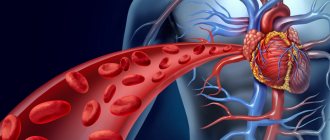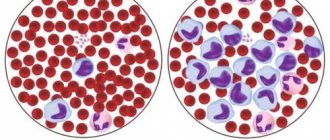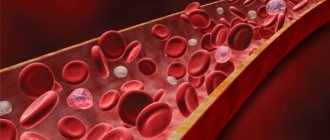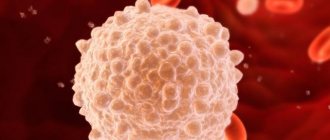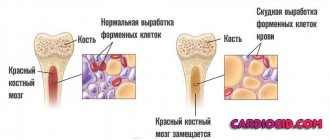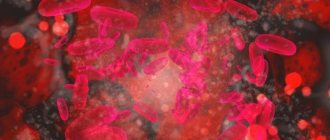You are here: Blood test -
Leukocytes in the blood
- General characteristics
- Norm and deviations
- Symptoms
- Diagnostics
- Treatment
- Prevention and prognosis
Leukocytes in the blood are components of the main biological fluid of the human body. They are divided into several subspecies, each of which performs its own specific function. The main task of white blood cells is to protect internal organs and systems from various infections.
The concentration of such substances has its own norm, which differs depending on the age category and gender. Acceptable indicators can either increase or decrease. Such deviations occur due to either pathological or physiological reasons.
If the leukocytes in the analysis differ from the acceptable values, then this will in any case affect the person’s well-being. For example, you may experience: dizziness, headaches, fatigue, weakness, increased temperature and problems sleeping.
The norm of leukocytes in the blood is calculated during the decoding of a general clinical analysis of biological fluid. However, to find the factor that provoked any deviation from the norm, a comprehensive examination is necessary.
The tactics for normalizing the concentration of such components of the main biological fluid are compiled individually for each person, but in general they are based on getting rid of the provoking disease. Leukocytes in the blood should always be normal.
General characteristics
Leukocytes in the blood are a group of cells that are responsible for the human body’s resistance to various pathogenic bacteria, viruses, helminths, parasites and other pathological microorganisms.
They also fight not only infectious agents, but also any foreign object:
- malignant or benign neoplasms of any location;
- transplanted donor organ;
- a foreign object that may accidentally enter the body.
The place of formation of leukocytes is blood stem cells, which are localized in the red bone marrow. In order to fully carry out their work, they undergo a large number of transformations, during which their structure and functions change.
In addition to blood, they are also found in fluids such as:
- urine;
- cerebrospinal fluid;
- pleural effusion;
- feces;
- gastric juice.
However, their concentration in such cases will be significantly lower, for example, for urine analysis, from 4 to 6 leukocytes are acceptable, and no more than 8 white blood cells should be present in the cerebrospinal fluid.
An increase or decrease in such blood components in any of the above structures most often indicates the occurrence of a disease.
In addition to the main task, the functions of leukocytes include:
- release of specific substances to combat various tumors;
- absorption and digestion of the pathogenic agent;
- relief of hemorrhages;
- acceleration of wound healing.
As stated above, white blood cells have several subtypes.
Thus, there are the following types of leukocytes:
- neutrophils - aimed at destroying bacterial infection;
- lymphocytes – responsible for the immune system and immune memory;
- monocytes - absorb and digest particles of foreign cells;
- eosinophils - fight allergen carriers;
- basophils - assist other particles in detecting foreign agents, however, they perform all their “duties” outside the bloodstream - in the internal organs.
It follows from this that subtypes of leukocytes perform their own mission.
Types of leukocytes
All types of such substances, in addition to their functions, differ in the following indicators:
- dimensions;
- core shape;
- way of development.
It is also worth noting about the structural features of each type of white blood cell. For example, neutrophils, eosinophils, basophils and monocytes are born from myeloblasts, the precursor of which is myelopoiesis. This happens under the influence of a stimulator cell in the bone marrow.
The lifespan of leukocytes is on average 2-4 days, and they are often destroyed in the liver, spleen and foci of inflammatory processes. The only exceptions are lymphocytes, some of which live in the human body from birth to death.
In neutrophils, eosinophils and basophils, the entire life cycle takes place in the bone marrow, which is why their immature cells are normally completely absent from the blood. Monocytes continue to exist in the spleen, liver and skeletal system, where they degenerate into macrophages and dendrocytes. Lymphocytes have a longer “life” in the spleen, lymph nodes and thymus.
Leukocytes received their common name - white blood cells - because, unlike red blood cells, they are colorless.
From all of the above, it follows that if there are no leukocytes in the blood, the human body simply will not be able to function.
Where are leukocytes formed in humans?
Human blood consists of formed elements and plasma. Leukocytes are one of these formed elements along with red blood cells and platelets. They are colorless, have a nucleus and can move independently. They can be seen under a microscope only after preliminary staining. From the organs where leukocytes are formed, they enter the bloodstream and body tissues. They can also freely pass from vessels to adjacent tissues.
Leukocytes move in the following way. Having secured itself on the wall of the vessel, the leukocyte forms a pseudopodia (pseudopod), which it pushes through this wall and clings to the tissue from the outside. Then it squeezes through the resulting gap and actively moves among other cells of the body that lead a “sedentary” lifestyle. Their movement resembles the movement of an amoeba (a microscopic single-celled organism from the category of protozoa).
Norm and deviations
The norm of leukocytes in the blood differs according to two parameters - gender and age category. The total number of such particles can be detected during a general blood test, but to identify the concentration of a particular subspecies, an extensive study of biological material is required.
Leukocytes should normally be:
- neutrophils – 55%;
- lymphocytes – 35%;
- monocytes – 5%;
- basophils – 1%;
- eosinophils – 2.5%.
In general, the normal leukocyte count in the blood is:
| Age category | Acceptable values (x 10^9/l) |
| Infants | 7-32 |
| Children under one year old | 6-18.5 |
| 1-2 years | 5-17 |
| 2-6 years | 5-16.5 |
| 6-15 years | 4.5-13.5 |
| Teenagers (16-21 years old) | 4.5-11 |
| Middle aged men | 4.2-9 |
| Middle aged women | 4-10.5 |
| Older men | 3-8.5 |
| Older women | 3.7-9 |
The number of white blood cells can also be affected by:
- time of day - in the morning there are fewer of them than in the evening, which is why a blood test should be taken during the day;
- food intake and physical activity - such factors increase the level of the described blood particles;
- time of year - in the hot season the concentration is increased, which is caused by the loss of a large amount of water through sweat;
- influence of stressful situations;
- taking medications, for example, steroid substances increase the amount, and antibacterial agents, diuretics, barbiturates, cytostatics and sulfonamides decrease it.
Also, the reasons that the norm of blood leukocytes increases (leukocytosis) are:
- a wide range of infectious and viral diseases;
- various allergic reactions;
- oncological processes;
- bone marrow damage;
- period of bearing a child.
The main sources of decreased normal values (leukopenia) are presented:
- chronic diseases;
- autoimmune processes;
- pathologies of the liver and spleen;
- oncopathologies;
- long-term irradiation of the body;
- congenital diseases that interfere with the formation of leukocytes;
- hypovitaminosis.
Both with leukocytosis and leukopenia, the body should be carefully examined to find the root cause.
Place of formation of leukocytes - functions, composition, leukocyte formula
The number of leukocytes is an important indicator for diagnosing pathological conditions.
The body constantly produces white blood cells, and their levels in the blood can change throughout the day. How are these cells produced and what role do they play in the human body? Place of formation of leukocytes
What are leukocytes
Several types of formed elements float in the blood, which support the health of the whole organism. White cells that have a nucleus inside are called leukocytes.
Their peculiarity is the ability to penetrate the capillary wall and enter the intercellular space.
It is there that they find foreign particles and absorb them, normalizing the vital activity of the cells of the human body.
Leukocytes
Leukocytes include several types of cells that differ slightly in origin and appearance. The most popular division is based on morphological characteristics. Morphology Type Normal quantity
| Granular (having granules in the cytoplasm) | Neutrophils | 70% |
| Eosinophils | 1-5% | |
| Basophils | Up to 1% | |
| Non-granular (no granules) | Lymphocytes | 21-35% |
| Monocytes | 4-8% |
The ratio of these cells is the same in all healthy people and is expressed by the leukocyte formula. By changing the number of any type of cells, doctors draw conclusions about the nature of the pathological process.
What are leukocytes
Important: it is leukocytes that maintain human health at the proper level. Most infections that enter the human body are asymptomatic due to a timely immune response.
Functions of leukocytes
The importance of leukocytes is explained by their participation in the immune response and protecting the body from any foreign agents. The main functions of white cells are as follows:
- Antibody production.
- Absorption of foreign particles – phagocytosis.
- Destruction and removal of toxins.
Functions of leukocytes
Each type of leukocyte is responsible for certain processes that help in carrying out the main functions:
- Eosinophils. They are considered the main agents for the destruction of allergens. They participate in the neutralization of many foreign components that have a protein structure.
- Basophils. They accelerate the healing process at the site of inflammation, due to the presence of heparin in its structure. Updated every 12 hours.
- Neutrophils. Participate directly in phagocytosis. Capable of penetrating into the intercellular fluid and into the cell where the microbe lives. One such immune cell can digest up to 20 bacteria. Fighting microbes, the neutrophil dies. Acute inflammation provokes a sharp production of such cells by the body, which is immediately reflected in the leukocyte formula as an increased number.
- Monocytes. Helps neutrophils. They are more active if an acidic environment develops at the site of inflammation.
- Lymphocytes. They distinguish their own cells from foreign cells by their structure and participate in the production of antibodies. They live for several years. They are the most important component of immune defense.
Leukocyte composition
Important : many doctors force you to do a clinical blood test before prescribing treatment. Viral and bacterial diseases cause different changes in the analysis, which makes it possible to make the correct diagnosis and prescribe the necessary medications.
Place of formation of leukocytes
All types of white blood cells are produced in the bone marrow, which is found inside the bones. It contains a huge number of immature cells, similar to those found in an embryo. From them, as a result of a complex multi-stage process, various hematopoietic cells are formed, including all types of leukocytes.
The transformation occurs as a result of the division of immature cells. With each stage they become more differentiated and designed to perform more specific functions. All stages, and there can be up to 9 of them, occur in the bone marrow. The exception is lymphocytes. To fully “grow up,” they will need to mature in the lymphoid organs.
Places of formation of leukocytes
Leukocytes accumulate in the bone marrow, and during the inflammatory process they enter the blood and reach the pathological focus. After fulfilling their purpose, the cells die, and the bone marrow forms new ones. Normally, only a small part of the body’s total leukocyte reserves floats in the bloodstream (up to 2%).
During the inflammatory process, all cells rush to the site of its localization. Neutrophil reserves for such emergency surges are located on the walls of blood vessels. It is this depot that allows the body to quickly respond to inflammation.
Types of leukocytes
Lymphocytes can mature into T or B cells. The former regulate the production of antibodies, and the latter recognize foreign agents and neutralize them. Intermediate T cell development occurs in the thymus.
The final maturation of lymphocytes occurs in the spleen and lymph nodes. It is there that they actively divide and turn into full-fledged immune defense.
During inflammation, lymphocytes move to the nearest lymph node.
Important: the mechanism of leukocyte formation is very complex. Don't forget the importance of the spleen and other organs. For example, drinking alcohol has a negative impact on them.
Lack of white blood cells
Leukopenia in an adult is a condition when the number of leukocytes is below 4*109/l. This may be caused by malignant diseases, exposure to radiation, vitamin deficiencies or problems with hematopoietic function.
Leukopenia leads to the rapid development of various infections and a decrease in the body's resistance. A person feels chills, body temperature rises, loss of strength and exhaustion appear. The body tries to compensate for the lack of defense cells, resulting in an enlarged spleen. This condition is very dangerous and requires identification of the cause and treatment.
What is leukopenia
Important: chronic fatigue or other conditions that have been bothering you for a long time should not be ignored. They often occur due to a decrease in the body's defenses.
Excess white blood cells
A leukocyte count above 9*109/l is considered to be above normal and is called leukocytosis. Physiological enlargement, which does not require treatment, can be caused by food intake, physical activity, certain hormonal surges (pregnancy, premenstrual period).
The following causes of leukocytosis lead to pathological conditions:
- Infectious diseases.
- Inflammatory processes of microbial and non-microbial etiology.
- Blood loss.
- Burns.
What is leukocytosis
Treatment for this condition may include the following groups of drugs:
- Antibiotics. They help eliminate the infection that caused leukocytosis and prevent complications.
- Steroid hormones. Quickly and effectively relieve inflammation, which leads to a decrease in the production of leukocytes.
- Antihistamines. Also help reduce inflammation.
The treatment tactics for any changes in the leukocyte formula depend on the cause that caused them.
Important: minor changes in the leukocyte formula may be temporary and even considered normal. Strong discrepancies with acceptable values or lack of changes during repeated analyzes should be alarming.
Children are taught about the importance of leukocytes at school. This topic is not an exaggeration. Good immunity ensures health and a good quality of life for every person. To determine the state of the immune system, you can take a blood test during the absence of illness. A competent doctor will help you interpret the results correctly.
— What does an increase in leukocytes in a blood test mean?
Source: https://med-explorer.ru/serdechno-sosudistaya-sistema/simptomatika-i-diagnostika-serdechno-sosudistaya-sistema/mesto-obrazovaniya-lejkocitov.html
Symptoms
Since leukocytes are formed in the bone marrow and are responsible for the state of the immune system, their increase or decrease will in any case affect the state of health.
With leukocytosis, the following often appear:
- weakness and fatigue;
- increased sweating;
- decreased vision;
- lack of appetite;
- aches in muscles and joints;
- attacks of dizziness.
When leukocytes in the blood are low, the symptoms will be as follows:
- decreased physical activity;
- headache;
- weight loss;
- enlarged spleen and liver;
- muscle and joint pain;
- hyperthermia.
In any case, the above symptoms will be supplemented by the most characteristic signs of the underlying disease.
Leukemia
How do white blood cells know that a virus has entered the body?
Every human cell contains an interferon system, which is part of the innate immune system. When a virus enters the body, interferon is produced - a protein substance that protects uninfected cells from the penetration of viruses into them. At the same time, interferon is one of the types of leukocytes. From the bone marrow, where white blood cells are produced, they travel to infected cells and destroy them. In this case, some viruses and their fragments fall out of the destroyed cells. The dropped viruses try to penetrate into uninfected cells, but interferon protects these cells from their entry. Viruses outside cells are not viable and die quickly.
Diagnostics
To establish the white blood cell index, a general clinical blood test is performed, which involves studying biological material taken either from a finger or from a vein.
The designation of leukocytes in a blood test is WBC, and in order for the real level of such substances to be detected, the patient needs to undergo simple preparation for such a diagnostic test.
Preparatory activities include:
- Complete refusal to eat on the day of the study - the analysis is carried out only on an empty stomach.
- Avoid taking any medications several weeks before the proposed examination. If this is not possible, the clinician should be informed about the use of medications.
- Female representatives do not donate blood during menstruation.
- A few days before the test, you should limit physical activity and avoid exposure to stressful situations.
The results are deciphered by a hematologist who transmits the received data to the attending physician. It must be taken into account that in order to identify an illness that could provoke a deviation from the norm, the information obtained during such a procedure will not be enough, which is why a comprehensive examination will be required.
Primary diagnosis includes activities carried out personally by the clinician:
- familiarization with the medical history;
- collection and analysis of life history;
- a thorough physical examination of the patient;
- a detailed survey of the patient - this is necessary for the doctor to obtain all data regarding the clinical picture;
Additionally, a person may be prescribed more extensive laboratory tests, various instrumental procedures and consultations with other specialists.
Indications for prescribing a leukocyte test
Since leukocyte analysis is carried out as part of a general blood test, every person who monitors their health undergoes it on a regular basis. These people also include pregnant women: in the absence of any signs of disease, they undergo this study regularly so that diseases and abnormalities in the development of pregnancy can be identified in advance.
In addition to medical examination, the analysis is taken during hospitalization and before surgery in order to conduct a basic examination and obtain information about the general condition of the body. As part of the diagnosis, a general analysis is prescribed if inflammatory processes in the body, parasitic infestations, infectious diseases and allergic reactions are suspected. Certain changes in the leukocyte composition may indicate oncology and serve as a reason for a more in-depth study.
This analysis is also used to assess the quality of treatment; the composition of the blood determines the effectiveness of the current drug therapy: perhaps the chosen plan does not help and needs to be adjusted.
Treatment
In order for leukocytes in the blood to return to normal, it is first necessary to get rid of the underlying disease, otherwise normalizing the values using conservative methods will be ineffective.
To reduce the content of white blood cells, medications such as:
- antibacterial substances;
- antacids;
- corticosteroids.
Along with taking medications, following a diet is indicated. It is best to exclude from the menu:
- fermented milk products;
- fatty meats and fish;
- greens and carrots;
- grapes and pomegranate;
- seafood and offal;
- fast food;
- oatmeal, buckwheat and rice.
You may also need leukapheresis, a procedure to cleanse the body of excess white blood cells.
If the level is low, the content of such blood components can be increased with the help of specially targeted drugs prescribed by the attending physician, as well as by introducing into the diet:
- dietary varieties of meat and fish;
- greens and fresh vegetables;
- legumes;
- dairy products;
- buckwheat and rice, oatmeal and corn porridge;
- nuts and dried fruits.
After consultation with a clinician, it is not prohibited to use traditional medicine recipes at home.
Prevention and prognosis
To ensure that the concentration and structure of leukocytes do not change, people only need to follow a few simple preventive measures:
- complete cessation of bad habits (smoking, alcohol);
- complete and balanced nutrition;
- avoiding the influence of stressful situations;
- taking medications prescribed by a specialist;
- undergoing a full examination in a medical institution at least 2 times a year.
The prognosis of leukocytosis or leukopenia is directly dictated by the primary source of such diseases. This is due to the fact that each of the pathological conditions has a number of its own complications and consequences.


